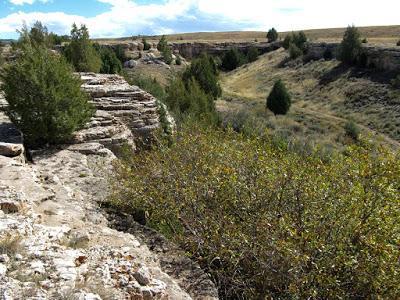
Though it's early October, this American pussy willow is not thinking fall.
As you may know, I'm following a tree. I’m not alone—fifty-plus other people around the world do the same. Early each month, we “gather” at a site kindly hosted by Lucy Corrander to report on our trees. And like so many trees, my willow hasn’t changed much since our last gathering. Is it waiting for a hard frost?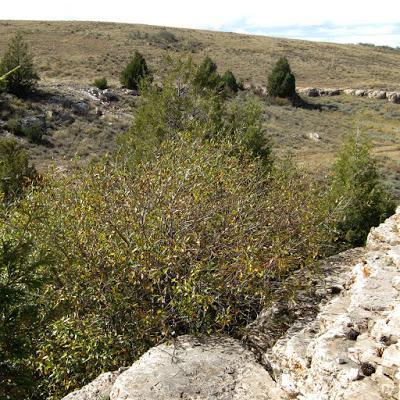
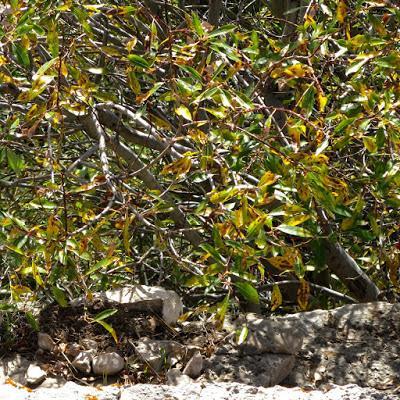
Some leaves are yellow, but no more than last month.
This pussy willow was the first wild plant I saw in bloom this year—back in cold snowy February! Salix discolor is famous for that. Will it be the last to lose its leaves?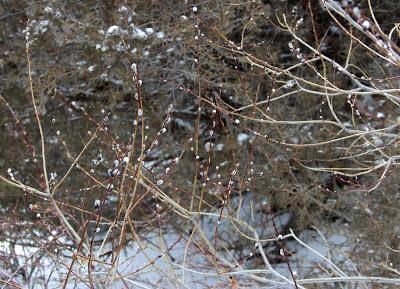
Mid-February: what a surprise to find this tree in bloom! I had to follow it.
Since there’s little to report, I decided to investigate one of the willow’s more curious traits—it’s a tree on drugs. It may not be addicted, but it certainly benefits from them. So do we! And we have for a long time.• • •
Back when botanists were mainly physicians and pharmacologists, some were experts in plant signatures: shapes of leaves, sizes of roots, patterns of flower petals. These indicated specific curative powers. God had made plants for man's use, and He revealed the uses to trained eyes. For example, the leaves of hepatica (liverleaf) are three-lobed like the human liver, and therefore cure ailments of the liver. The eye-like flowers of eyebright (Euphrasia) point to treatment of eye problems.
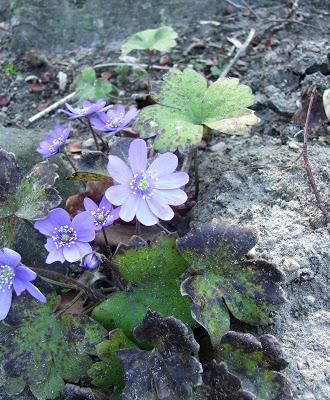
Liver problems? Try Hepatica transsilvanica (source).
This Doctrine of Signatures was in use in ancient Greece by the first century AD. In the 1500s, the Swiss-German botanist-pharmacologist Paracelsus advanced and formalized it: "Nature marks each growth,” he wrote, “according to its curative benefit.” Later the Doctrine expanded beyond shapes to include plant environments. Diseases of a given habitat could be cured by plants of that habitat. The biggest success was the treatment of agues—afflictions of damp lowlands (probably malarial fevers).In 1763, the Rev. Mr. Edward Stone wrote a letter to the Royal Society describing in a scientific manner (for the day) the effectiveness of willow bark in curing agues, so “the world may reap the benefits accruing from it.” He explained what had led him to try it:
“As this tree delights in a moist or wet soil, where agues chiefly abound, the general maxim that many natural maladies carry their cures along with them or that their remedies lie not far from their causes was so very apposite to this particular case that I could not help applying it.”Stone gathered nearly a pound of willow bark, dried it for three months, and pounded it into a powder. He soon had an opportunity to try it on a sufferer. Not knowing effects nor potency, he first administered small amounts. He observed some improvement, with not the “least ill consequences.” With increased dosage “the ague was soon removed.” Stone continued treatments for five years before he wrote his letter:
“It hath been given I believe to fifty persons, and never failed in the cure, except in a few autumnal and quartan agues, with which the patients had been long and severely afflicted; these it reduced in a great degree” (Stone 1763).
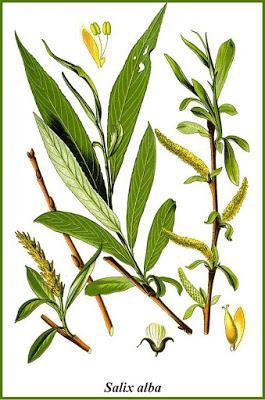
Stone collected bark of the “common white Willow”—Salix alba (source).
Thomas MacLagan is credited with the first clinical trials of willow bark, in 1876. His interest was rheumatism. First, he himself took salicylic acid and salicin (a derivative) with no ill effects. He then gave patients suffering from acute rheumatism two grams of either salicylic acid or salicin, and found them equally effective:
“I have used salicylic acid and salicin in every case of acute rheumatism which has come under my care since November 1874 (a year and a half), and invariably with the same result—a rapid cure of the disease. Seeing a patient suffering from acute rheumatism, I have no hesitation in assuring him that within forty-eight hours, possibly within twenty-four, he will be free of pain.”Even though his training and approach were scientific, MacLagan still relied on the Doctrine of Signatures:
“It seemed to me that a remedy for that disease [rheumatism] would most hopefully be looked for among those plants and trees whose favorite habitat presented conditions analogous to those under which the rheumatic miasma seemed most to prevail. A low-lying damp locality, with a cold rather than warm climate, gives the conditions under which rheumatic fever is most readily produced” (MacLagan 1876).As medicine progressed, the Doctrine of Signatures fell out of favor (it reappeared in the 1960s as “like cures like”—homeopathy). But the efficacy of willow bark remained widely recognized. Salicylic acid, which occurs in other plants besides willow, was first isolated in 1859, and was in factory production by 1874.
Salicylic acid has harmful side effects, mainly nausea and irritation of the stomach (salicin less so). A German company, Bayer, found a way to convert it to acetylsalicylic acid, which is much more tolerable and equally effective. They called it “aspirin”—combining “a” from acetyl with “spi” from spirea (meadowsweet), their source of salicylic acid. In 1887, aspirin became the first synthetic drug, and remains the most commercially successful. [Bayer lost ownership of the name “aspirin” at the end of World War I, a long story—see Jack 1997.]But why do willows make salicylic acid? What do they use it for? (probably not rheumatism)
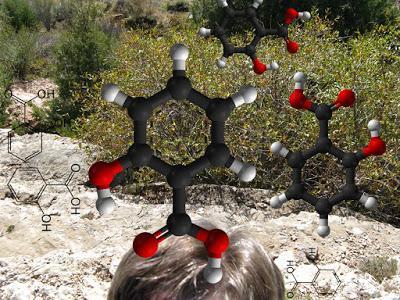
Tree-on-drugs selfie.
Salicylic acid is a secondary metabolite, meaning it’s manufactured by plants (a metabolite) but is not essential (secondary). Primary metabolites are used in fundamental pathways, and are found across the plant kingdom, whereas secondary metabolites are restricted to certain groups. Their functions are diverse: regulate growth, attract pollinators, deter predators, and more (see this excellent summary). Interestingly, though plants make secondary metabolites for their own use, we humans find many of them valuable—quinine, digitalis, caffeine, nicotine, cocaine, and of course salicylic acid. [Hot-off-the-press: A secondary metabolite, artemisinin, is the reason Tu Youyou is one of this year's recipients of the Nobel Prize in Medicine. It's used in treating malaria.]We may classify salicylic acid as secondary, but for the willow, it's hardly non-essential. It plays important roles in “growth and development, photosynthesis, transpiration, ion uptake and transport. [It] also induces specific changes in leaf anatomy and chloroplast structure, [and] is involved in plant defense against pathogens” (source).Humans are not the only critters that benefit from the willow’s drugs. Some Chrysomela beetles eat willow leaves and sequester salicylic acid … not for rheumatism or headaches, but rather to make themselves distasteful to their predators. Life will evolve to meet an opportunity! For more, see To Make a Willow Weep at Catalogue of Organisms. Join us!
Join us!Sources (in addition to links in post)Jack, DB. 1997. One hundred years of aspirin. The Lancet 350:437-39.doi:10.1016/S0140-6736(97)07087-6MacLagan, T. 1876. The treatment of rheumatism by salicin and salicylic acid. Br Med J 1:627. PDF
Reader’s Digest. 1986. Magic and medicine of plants.
Stone, E. 1763. An account of the success of the bark of the willow in the cure of agues. Phil Trans 53:195-200. PDF
